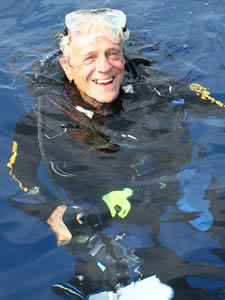The world’s coral reefs are in great danger from dual threats of rising temperatures and ocean acidification, Charlie Veron, Former Chief Scientist of the Australian Institute of Marine Science, told scientists attending the Association for Tropical Biology and Conservation meeting in Sanur, Bali.
Tracing the geological history of coral reefs over hundreds of millions of years, Veron said reefs lead a boom-and-bust existence, which appears to be correlated with atmospheric carbon dioxide levels. With CO2 emissions rising sharply from human activities, reefs—which are home to perhaps a quarter of marine species and provide critical protection for coastlines—are poised for a “bust” on a scale unlike anything seen in tens of millions of years.
 Veron said the 450 ppm level targeted in most international climate talks would destroy coral reefs. To maintain coral reefs as the healthy and productive ecosystems we cherish today, the world must instead aim for a 320-350 ppm target, well below the current 387 ppm. |
In particular, said Veron, reefs are endangered by ocean acidification, which reduces the availability of free carbonate ions in sea water, making more difficult for marine organisms to extract calcium carbonate to build the aragonite and calcite shells and skeletons they need to survive. Some of the most affected creatures are tiny polyps that build coral reefs. As the calcification rates slow, so does the growth of coral reefs, leaving them vulnerable to weathering from wave action and other stress. Other marine life is affected too, including microorganisms that form the base of the oceanic food chain.
Reefs are also threatened by rising sea temperatures, which increase the incidence of “bleaching.” Bleaching causes coral to expel symbiotic zooxanthellae algae living in their tissues — algae that provide corals with nourishment. Corals can recover from short-term bleaching, but prolonged bleaching (over a week) can cause damage that requires 20 years or longer for recovery. Since 1979 there have been at least eight mass-bleaching events, each of which has been progressively more frequent and severe.
Looking at future projections for atmospheric CO2 concentrations, Veron painted a dire outlook for the world’s coral reefs. By 2015, when global CO2 levels are expected to reach 400 ppm, coral reefs will be besieged by severe bleaching events. By 2030 to 2040, when CO2 levels reach 450 ppm, the limit targeted by negotiators at climate change discussions in Copenhagen last year, severe bleaching will hit reefs on nearly an annual basis. Ocean acidification could begin to kill off large numbers of marine life, especially coral species. By 2060, with CO2 levels at 600 ppm, elevated sea temperatures and acidic conditions will conspire to change “everything we know about marine life today,” according to Veron. Corals will be disappear from depths shallower than 10 meters and reefs will suffer extensive degradation from weathering, triggering yet more extinction. A century from now, corals will be extinct or at least askeletal. Reefs will be mostly “wave-washed geological structures” rather than the productive ecosystems we know today. Mollusks will sharply decline. Reef-dependent species and human societies will be forever altered.
 Great Barrier Reef in Australia |
Veron concluded his talk with an explantation of his decision to leave the academic world and move into advocacy on behalf of reducing greenhouse gas emissions and protecting coral reefs. The author of more than 100 scientific articles and discoverer of 20 percent of the world’s coral species, said that any of the coral-related research of scientists in attendance would be rendered irrelevant by the end of the century should CO2 emissions continue their business-as-usual trajectory.







